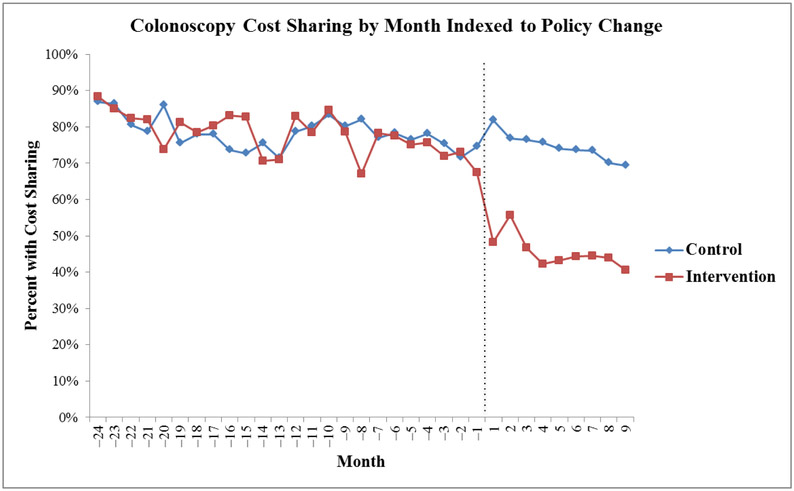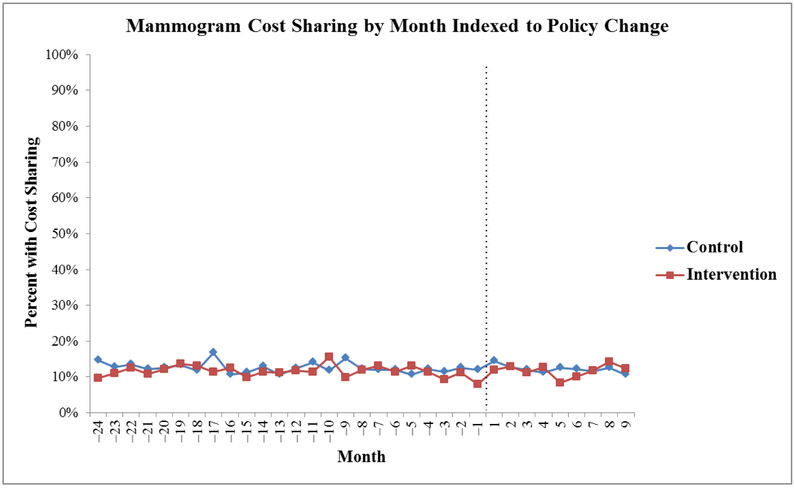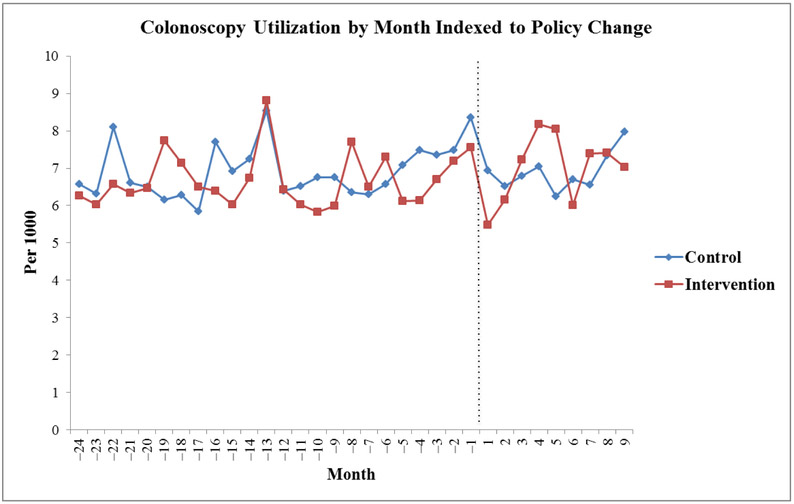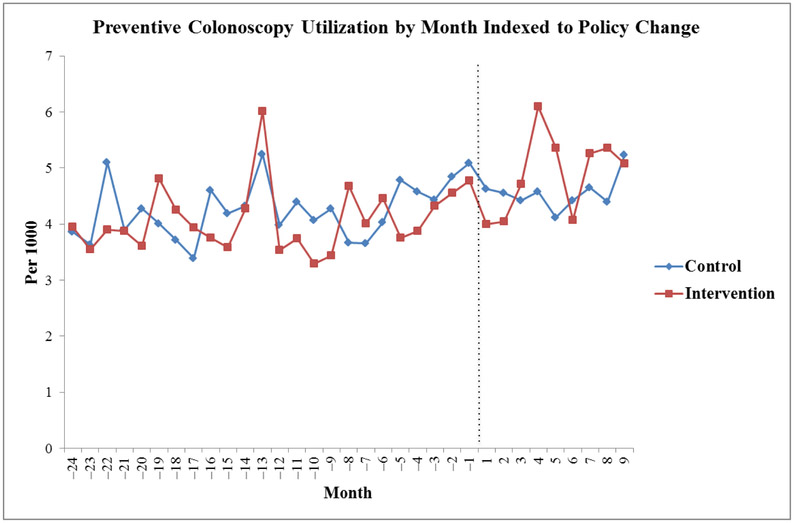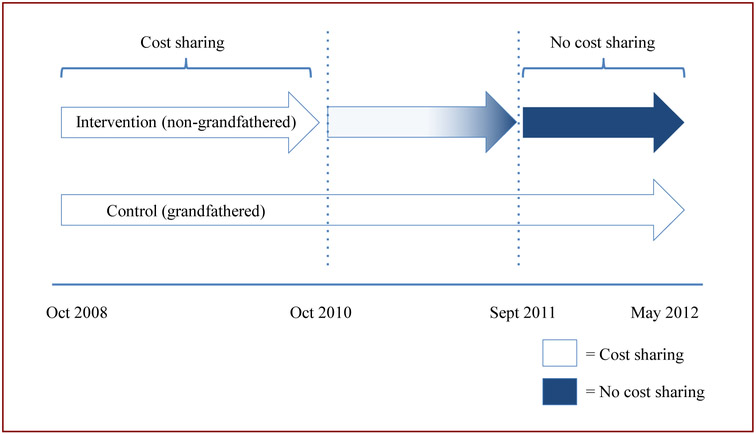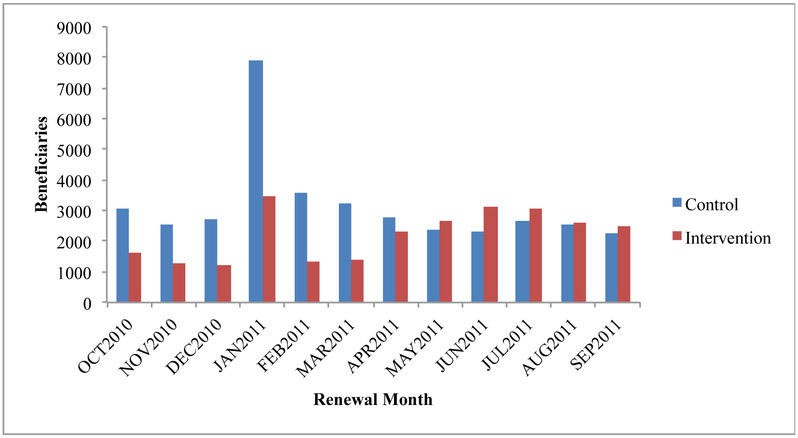Abstract
Objectives:
The Affordable Care Act (ACA) eliminated patient cost sharing for evidence-based preventive care, yet the impact of this policy on colonoscopy and mammography rates is unclear. We examined the elimination of cost sharing among small business beneficiaries of Humana, a large national insurer.
Study Design:
This was a retrospective interrupted time series analysis of whether the change in cost sharing policy was associated with a change in screening utilization, using grandfathered plans as a comparison group.
Methods:
We compared beneficiaries in small-business non-grandfathered plans that were required to eliminate cost sharing (intervention) with those in grandfathered plans that did not have to change cost sharing (control). There were 63,246 men and women aged 50 to 64 years eligible for colorectal cancer screening, and 30,802 women aged 50 to 64 years eligible for breast cancer screening. The primary outcome variables were rates of colonoscopy and mammography per person-month, with secondary analysis of colonoscopy rates coded as preventive only.
Results:
There was no significant change in the level or slope of colonoscopy and mammography utilization for intervention plans relative to the control plans. There was also no significant relevant change among those colonoscopies coded as preventive.
Conclusions:
The results suggest that the implementation of the policy is not having its intended effects, as cost-sharing rates for colonoscopy and mammography did not change substantially, and utilization of colonoscopy and mammography changed little following this new policy approach.
Précis:
The ACA eliminated patient cost sharing for evidence-based preventive care, yet this policy has not resulted in substantial increases in colonoscopy and mammography utilization.
The Affordable Care Act (ACA) of 2010 contains provisions to reduce financial barriers for evidence-based preventive care. Specifically, it mandates that health insurance plans provide benefits for, and require no cost sharing for, services recommended with a rating of A or B by the United States Preventive Services Task Force (USPSTF).1
Despite aggressive efforts to increase breast and colorectal cancer screening in the past decade, screening rates remain suboptimal.2 Across the United States, the rates of colorectal and breast cancer screening are 59% and 72%, respectively.3,4 The ACA policy attempts to increase these rates through first-dollar coverage of these screening tests.
Patient cost sharing has been shown in a variety of contexts to be an important driver of health service utilization.5 Higher cost sharing has been shown to reduce utilization of services and has the potential downside of reducing both desirable and less desirable healthcare utilization.6–10 Concerns about the impact of higher cost sharing on cancer screening rates and preventive service utilization have been heightened by the proliferation of high-deductible insurance plans.11
Per ACA policy, all new private insurance plans were required to eliminate cost sharing for such services starting in September 23, 2010, with Medicare plans facing similar requirements starting January 1, 2011. Commercial plans were designated as “grandfathered” if they existed on March 2010 and did not make any coverage changes. In this study, we examine the impact of the elimination of cost sharing for preventive services on colon and breast cancer screening rates among beneficiaries of Humana, a large national private health insurance plan, using grandfathered plans as a control group. We hypothesize that there will not be a dramatic impact of the policy on preventive health utilization due to the lack of knowledge about cost sharing and additional patient barriers to screening.
METHODS
Data Source and Study Population
We analyzed de-identified data from Humana for all beneficiaries aged 50 to 64 years who were enrolled in small business plans at any time between October 2008 and May 2012. Member eligibility files included beneficiary coverage and benefit design files describing different characteristics of each plan, including grandfather status.
Patient-level data obtained from the beneficiary file included age, gender, and plan type, along with census tract data for income, race, and education. Using Healthcare Effectiveness Data and Information Set (HEDIS) coding (eAppendix 1, available at www.ajmc.com),12 claims data were obtained for colorectal cancer screening (colonoscopy, fecal occult blood testing, and flexible sigmoidoscopy) and breast cancer screening (mammography). Colonoscopies were defined as “preventive” if associated with the designated diagnosis code (V16.0, V18.51, V76.41, V76.51).
Eligible patients for colorectal cancer screening included men and women aged 50 to 64 years, and breast cancer screening included women aged 50 to 64 years, as per the USPSTF recommendations.13 Patients 65 years or older were not included since they would be eligible for Medicare at that time.
The primary outcome variables were rates of colonoscopy and mammography per person-month, and the secondary outcome was rate of colonoscopy coded as preventive per person-month. We did not exclusively measure procedures used only for cancer screening. Likewise, we did not measure the proportion of the population that was up-to-date with screening as the turnover of the insurer’s population limited ability to look back and fully capture prior use of these screening tests. Rather, we looked at the overall utilization rates without a look-back period to examine differential rates in screening as a result of the policy. Colonoscopy is the primary modality for colorectal cancer screening in this country,3 and even when employed for the evaluation of symptoms serves as a diagnostic test for colorectal cancer. We also found predominant use of colonoscopy in our sample, with no increase in fecal occult blood tests over time and minimal flexible sigmoidoscopy use (data not shown).
Cost sharing refers to the out-of-pocket costs paid by the beneficiary, which includes co-payment, deductible, and coinsurance for all the claims related to the procedure (physician and facility) billed on the same day. Given the nature of the policy reform, we examined the percentage of colonoscopies and mammograms with greater than zero cost sharing, but also looked at the mean cost sharing amount.
For the purposes of the analysis, time zero was the first renewal month for each plan after September 2010. Changes in benefit design for small business plans are typically made during the renewal month, which is plan-specific and is distributed throughout the year, so time zero ranged from October 2010 to September 2011 for the different plans (eAppendix 2). Small business plans were categorized as non-grandfathered or grandfathered, as denoted by the insurer, based on whether they were required by the policy to have no cost sharing for preventive procedures. Hereafter, we will refer to the non-grandfathered plans as the intervention group and the grandfathered plans as the control group.
We only included beneficiaries enrolled in plans that were in existence on March 2010, which was the time when grandfathered status was determined. To be included in the analysis, beneficiaries had to be continuously enrolled for 2 years prior to the change in the policy (time zero) and for a minimum of 9 months afterwards. This allowed us to analyze the impact of policy change on a consistent cohort over time. There were members from 23,028 unique small-business coverage plans enrolled from 48 states. The 5 states with the most enrollees were Texas (20.6%), Illinois (15.9%), Kentucky (9.8%), Florida (8.5%), and Wisconsin (6.8%).
Statistical Methods
We assigned time zero to the renewal time during the policy change period to normalize the policy effect and assess overall trends for 24 months before and 9 months after time zero (ranging from month –24 to +9). Thus, time zero and the months did not all occur at the same time for different plans. We first looked at the proportion of colonoscopy and mammography with greater than zero cost sharing and the degree to which this changed following implementation of the new policy. We then assessed trends in procedure utilization for the eligible cohort of beneficiaries that were continuously enrolled, demonstrating this graphically.
We used an aggregate-level “differenced” interrupted time series to examine whether the change in cost sharing policy was associated with a change in screening utilization for the small-business population, since this was the group for which we could directly compare rates in plans that had benefit design changes (intervention group) and those that were grandfathered (control group). Using this design, we compared each intervention and control group with itself, before and after the policy change.14,15 This approach reduces potential biases from unmeasured variables and accounts for underlying changes in screening rates over time that are constant between both groups and might reflect general changes in clinical practice.16 The intervention and control groups had similar characteristics (Table 1), and individual designation to those groups was at the plan level. Education, race, and income data were obtained from the census tract data for the area of residence of the beneficiary. We assigned small business plans to intervention and control group based on designation by the insurer.
Table 1.
Characteristics of Colonoscopy and Mammography Cohorts for Different Plan Types
| Colonoscopy | Mammography | |||
|---|---|---|---|---|
| Intervention | Control | Intervention | Control | |
| Members (n) | 25,926 | 37,320 | 12,603 | 18,199 |
| Percent female | 49% | 49% | – | – |
| Mean age: years | 55.2 | 55.3 | 55.2 | 55.3 |
| Percent in census tract with ≥high school education | 73% | 74% | 73% | 74% |
| Percent residing in census tract with ≥80% white population | 71% | 72% | 70% | 72% |
| Median income in census tract | $68,700 | $70,200 | $68,100 | $69,600 |
For this interrupted time series analysis, the outcome of interest was the aggregate difference between the rate of colonoscopy or mammography for the intervention and control group. This was determined at each monthly time point by calculating the difference between the rates (per 1000 beneficiaries) of the intervention and control group, which resulted in 33 data points. We utilized a generalized linear regression model, which included variables for month, post policy, and month post policy. A secondary analysis was performed looking only at colonoscopies coded as preventive. The “post policy” coefficient provides the level change (absolute difference) in percent screened between the study groups in the month immediately after the policy, and the coefficient of “month post policy” demonstrates any slope change after the policy. These 2 variables are the coefficients of interest, as they evaluate the changes in level and slope for colonoscopy and mammography rates, controlling for baseline trend. A positive coefficient represents a relative increase in the level or slope of monthly screening rate for members in the intervention plans compared with the control plans from pre- to post policy change.
All analyses were carried out using SAS software version 9.3 (SAS Institute, Cary, North Carolina). Approval for this study was obtained from the Institutional Review Board of the University of Pennsylvania. Humana was involved in the design and conduct of the study, in the collection and interpretation of the data, and in the review of the manuscript.
RESULTS
Demographics
For colonoscopy and mammography, the intervention and control groups had similar demographic characteristics including age, gender, education, race, and income (Table 1). There were 25,926 members in the intervention group and 37,320 members in the control group for colonoscopy, which was 49% female in both groups. Mean ages were 55.2 years and 55.3 years; percentages with greater than high school education were 73% and 74%; percentages living in areas with greater than 80% white population were 71% and 72%; and median incomes for census tract were $68,700 and $70,200 in the colonoscopy intervention and control groups, respectively. There were 12,603 members in the intervention group and 18,199 members in the control group for mammography. Mean ages were 55.2 and 55.3 years; the percentage with greater than high school education were 73% and 74%; the percentage living in areas with greater than 80% white population was 70% and 72%; and median incomes for census tract were $68,100 and $69,600 in the mammography intervention and control groups, respectively.
Cost Sharing Changes
Approximately 75% of small business plan colonoscopies required cost sharing for an overall mean amount of about $650 before the policy change for both intervention and control groups. After the change, the percentage of intervention group procedures with non-zero cost sharing dropped from 75% to 45%, while the control group rate of procedures with non-zero cost sharing remained at 75% (Figure 1a). Post policy, the mean cost sharing remained at $650 for the control and reduced to about $350 in the intervention group. Among colonoscopies that were coded as preventive, there was a larger reduction in the proportion of procedures with zero cost sharing (Figure 1b), with a drop in intervention group plans from 65% to approximately 15%. Before the policy, preventive coded colonoscopies had a mean cost sharing of about $600 for intervention and control, which reduced to about $100 for the intervention group post policy.
Figure 1.
a. Trends in Cost Sharing for Colonoscopy Before and After Policy Change
b. Trends in Cost Sharing for Preventive Colonoscopy Before and After Policy Change
c. Trends in Cost Sharing for Mammography Before and After Policy Change
Many insurance plans had already made efforts to reduce cost sharing for mammograms prior to the policy change, so only about 10% of procedures in the intervention and control group had cost sharing before and after the policy change (Figure 1c).
Interrupted Time Series Regression
There was not a consistent increase in colonoscopy utilization following the reduction in patient cost sharing for colonoscopies in 2010 (Figure 2a and Figure 2b). Interrupted time series regression analysis examining the aggregate difference in colonoscopy screening rates between the intervention and control group showed no significant change in level immediately after the policy change (coefficient = 0.31; P = .68) or in the slope change in utilization (coefficient = 0.054; P = .66) (Table 2). We also performed an analysis of colonoscopies coded as preventive only and found no significant relative change in the absolute difference (coefficient = 0.16; P = .78) or slope change in utilization (coefficient = 0.091; P = .32) after the policy change (Table 2).
Figure 2.
a. Trends in Utilization of Colonoscopy Before and After Policy Change
b. Trends in Utilization of Preventive Colonoscopy Before and After Policy Change
c. Trends in Utilization of Mammography Before and After Policy Change
Table 2.
Aggregate Differences in Colonoscopy, Preventive Colonoscopy, and Mammography Utilization for Intervention as Compared to Control
| Colonoscopy | Preventive Colonoscopy |
Mammography | ||||
|---|---|---|---|---|---|---|
| Coefficient (SE) |
P | Coefficient (SE) |
P | Coefficient (SE) |
P | |
| Month | –0.015 (0.03) | .58 | –0.007 (0.02) | .73 | –0.033 (0.10) | .73 |
| Post Policy | 0.31 (0.76) | .68 | 0.16 (0.57) | .78 | 1.24 (2.7) | .65 |
| Month Post Policy | 0.054 (0.12) | .66 | 0.091 (0.09) | .32 | 0.093 (0.43) | .83 |
Outcome is the monthly difference in utilization rates between Intervention and Control. Post Policy coefficient refers to the level change (absolute difference) in utilization between the study groups in the month immediately after the policy.
Month Post Policy coefficient describes any slope change in utilization after the policy. Includes 63,246 members (30,802 for mammography) aged 50-64 years with continuous coverage for 2 years before time zero and 9 months after time zero.
The annual utilization rate of mammography also changed little after the policy change (Figure 2c). For mammography, comparing the aggregate difference in small business cohort screening rates had a nonsignificant change in the level immediately after the policy change (coefficient = 1.24; P = .65) and in the slope change in utilization (coefficient = 0.093; P = .83) (Table 2). Thus, similar to the limited impact on colonoscopy, there was no significant increase in mammogram utilization after implementation of the policy change in this population.
DISCUSSION
This is the first study to examine the impact of the ACA cost sharing elimination policy on colonoscopy and mammography use in an insured population. Utilization of colonoscopy and mammography changed little following the implementation of this new policy. A potential, and perhaps unanticipated, reason for the limited effect is that only preventive-coded colonoscopies were subject to the policy. Only about 60% of eligible colonoscopies in small business plans were coded as preventive following the policy implementation. However, despite this, there was a significant reduction in the proportion of colonoscopies with cost sharing for the intervention group, while the proportion of those with cost sharing in the control group remained the same. Furthermore, even among the subset of colonoscopies coded as preventive, for which the policy is specifically directed, we did not find a significant increase in colonoscopy utilization.
Mammography rates were also affected minimally since few mammograms required cost sharing before the policy change, so the policy only impacted a small proportion of beneficiaries. Meanwhile, the percentage of mammograms with cost sharing did not drop to zero because some were coded as diagnostic as opposed to preventive. This reflects aggressive efforts to improve breast cancer screening rates that predated the ACA policy and limited the potential impact of this legislation on mammography screening rates. There was also the possibility that the ACA may draw attention to preexisting policies that required no cost sharing for certain preventive services and drive an increase in behavior, yet we did not find evidence of this.
Another potential reason for the limited initial impact may be that patients and their physicians were unaware of these co-payment reductions for a relatively infrequent screening test.17 Patients are given feedback of medication cost sharing every time they refill, while cancer screening is a relatively rare event—particularly in the case of routine screening colonoscopy every 10 years. This plan policy change was communicated during annual renewal, which supplemented existing efforts by Humana to remind beneficiaries about screening through automated phone calls, e-mail, and direct mail. However, insurance benefit design is typically complicated, and patients have difficulty accurately estimating out-of-pocket healthcare payments.18 Additionally, if a polyp was removed or if a procedure is coded for any symptoms (ie, change in bowel habits, bleeding), such colonoscopies are typically billed as diagnostic colonoscopies rather than preventive, and they are thereby subject to cost sharing. Even if patients were informed of the ACA policy change for preventive care, it would have been difficult for them to predict whether their procedure would be coded as preventive or diagnostic. After this study period, there was a clarification by the government in 2013 that stated that private insurers may not require cost sharing for colonoscopy with polyp removal performed as a screening procedure, but this does not apply to the Medicare population.19
A third reason for the limited initial impact may be an asymmetry in response to cost sharing changes. Value-based insurance designs that reduce cost sharing for high-value medications have resulted in small increases in adherence relative to the decrements that have been observed from co-payment increases.20–24 We had expected that patients might respond less to changes in the degree of cost sharing for a colonoscopy than for other healthcare interventions due to the invasive and unpleasant nature of the test. There also may be additional costs to colonoscopy such as time off from work and the requirement of an escort that could be calculated by the patient.25
Limitations
The main limitation of this study is that it looked at the post policy time period for 9 months, and it may take longer for intended effects to manifest. However, we did apply the same analysis to the smaller cohort of beneficiaries for whom we had 12 and 15 months of post policy data and still found the same nonsignificant results. Additionally, there was substantial room for improvement, as publicly reported Humana HEDIS rates in 2010 were 63.7% and 76.9% for colorectal cancer and breast cancer screening, respectively.26 Another limitation is that there was no way to take into account the appropriateness of the test or prior screening utilization for both colonoscopy and mammography. Because of insurance company turnover, requiring an additional 1 year of prior enrollment only included 62% and 2 years would have included only 39% of the insured population. This is particularly challenging in assessing colorectal cancer screening rates since screening prior colonoscopy may have occurred up to 10 years before. However, assessing utilization within different time windows should not be biased differentially by our approach, and an analysis of only colonoscopies coded as preventive showed similar results.
Another potential limitation is that there may have been changes in coding practice for these procedures, but it is likely to have been consistent for both study groups. There also may have been additional changes in benefit design for the intervention group such as reduction of cost sharing for primary care visits, but they would be likely to bias toward a significant finding. We also looked at whether there was a difference in distribution of plan renewal months for the intervention and control groups and found a slight increase in intervention renewal in the later months (eAppendix 3). Assuming that it may take time for the policy to take hold, this difference would also bias toward a greater impact of the policy on the intervention group. Finally, we studied small business plans in 1 insurer, but with beneficiaries in 48 states, these results should be generalizable to other commercially insured populations. Additionally, this population offered the unique advantages of having a natural control group and relatively higher cost sharing than other plans before the policy change.
CONCLUSIONS
While the waiver of cost sharing for preventive services was introduced with a goal of increasing cancer screening rates, the implementation of the policy to eliminate cost sharing has not increased rates of colonoscopy and mammography to a significant degree. Consideration should be given to waiving cost sharing for all colonoscopies and mammograms in the eligible population as opposed to just those that are coded as preventive, as many of these contribute to the screening and surveillance process. Additional communication and education about the policy alone may not be sufficient. Interventions need to be developed and studied that could lower the price of a colonoscopy below zero to offset the time and hassle costs of the procedure, make the process of obtaining screening easier, or address other patient barriers to screening
Take-Away Points.
The ACA eliminated patient cost sharing for evidence-based preventive care, yet the implementation of this policy in a large national insurer has not resulted in substantially higher utilization of colonoscopy and mammography.
Only those colonoscopies coded as preventive were eligible for the policy change, so many patients were still subject to cost sharing.
Many physicians and patients may have been unaware of cost sharing for this policy change prior to having the procedure done.
Additional measures are needed to increase screening rates, including waiving cost sharing for all eligible colonoscopies or making financial incentives more salient to patients.
Acknowledgments
Feifei Yang contributed to the preliminary analysis of this study.
Source of Funding: Humana, National Institutes of Health (K24 DK078228, T32 DK007740).
Appendix
eAppendix 1.
HEDIS Procedure Codes for Colorectal and Breast Cancer Screening
| Colorectal Cancer Screening | |
| Colonoscopy | CPT: 44388–44394, 44397, 45355, 45378–45387, 45391, 45392. HCPCS: G0105, G0121. ICD-9-CM: 45.22, 45.23, 45.25, 45.42, 45.43. |
| Fecal occult blood test | CPT: 82270, 82274. HCPCS: G0328. |
| Flexible sigmoidoscopy | CPT: 45330–45335, 45337–45342, 45345. HCPCS: G0104. ICD-9-CM : 45.24. |
| Breast Cancer Screening | |
| Mammography | CPT: 77055–77057. HCPCS: G0202, G0204, G0206. ICD-9-CM: 87.36, 87.37. |
CPT indicates Current Procedural Terminology; HCPCS, Healthcare Common Procedure Coding System; ICD-9-CM, International Classification of Diseases, Ninth Revision, Clinical Modification.
eAppendix 2.
ACA Cost Sharing Policy for Humana Small-Business Plans
eAppendix 3.
Renewal Month for Study Beneficiaries After ACA Policy
Footnotes
Author Disclosures: Drs. Mehta and Volpp received a grant from Humana for this research study. Dr Volpp is a consultant for VAL Health and CVS Caremark, and has received grants from Humana, CVS Caremark, and Discovery. The remaining authors report no relationship or financial interest with any entity that would pose a conflict of interest with the subject matter of this article.
REFERENCES
- 1.“Patient Protection and Affordable Care Act (the Affordable Care Act)” http://www.hhs.gov/healthcare/rights/law/patient-protection.pdf Accessed on June 24, 2015.
- 2.Centers for Disease Control and Prevention. Vital signs: colorectal cancer screening among adults aged 50–75 years - United States, 2008. MMWR Morb Mortal Wkly Rep. 2010;59(26):808–812. [PubMed] [Google Scholar]
- 3.Joseph DA, King JB, Miller JW, Richardson LC; Centers for Disease Control and Prevention. Prevalence of colorectal cancer screening among adults--Behavioral Risk Factor Surveillance System, United States, 2010. MMWR Morb Mortal Wkly Rep. 2012;61 Suppl:51–56. [PubMed] [Google Scholar]
- 4.Miller JW, King JB, Joseph DA, Richardson LC; Centers for Disease Control and Prevention. Breast cancer screening among adult women--Behavioral Risk Factor Surveillance System, United States, 2010. MMWR Morb Mortal Wkly Rep. 2012;61:46–50. [PubMed] [Google Scholar]
- 5.Newhouse JP; Insurance Experiment Group. Free for All? Lessons From the Rand Health Insurance Experiment. Cambridge: Harvard University Press; 1993. [Google Scholar]
- 6.Doshi JA, Zhu J, Lee BY, Kimmel SE, Volpp KG. Impact of a prescription copayment increase on lipid-lowering medication adherence in veterans. Circulation. 2009;119(3):390–397. [DOI] [PMC free article] [PubMed] [Google Scholar]
- 7.Schneeweiss S, Patrick AR, Maclure M, Dormuth CR, Glynn RJ. Adherence to statin therapy under drug cost sharing in patients with and without acute myocardial infarction: a population-based natural experiment. Circulation. 2007;115(16):2128–2135. [DOI] [PubMed] [Google Scholar]
- 8.Wharam JF, Galbraith AA, Kleinman KP, Soumerai SB, Ross-Degnan D, Landon BE. Cancer screening before and after switching to a high-deductible health plan. Ann Intern Med. 2008;148(9):647–655. [DOI] [PubMed] [Google Scholar]
- 9.Dorn SD, Wei D, Farley JF, et al. Impact of the 2008–2009 economic recession on screening colonoscopy utilization among the insured. Clin Gastroenterol Hepatol. 2012;10(3):278–284. [DOI] [PMC free article] [PubMed] [Google Scholar]
- 10.Trivedi AN, Rakowski W, Ayanian JZ. Effect of cost sharing on screening mammography in Medicare health plans. N Engl J Med. 2008;358(4):375–383. [DOI] [PubMed] [Google Scholar]
- 11.Beeuwkes Buntin M, Haviland AM, McDevitt R, Sood N. Healthcare spending and preventive care in high-deductible and consumer-directed health plans. Am J Manag Care. 2011;17(3):222–230. [PubMed] [Google Scholar]
- 12.HEDIS 2015: Healthcare Effectiveness Data and Information Set. Vol. 2, technical specifications for health plans. Washington (DC): National Committee for Quality Assurance (NCQA); 2014. http://www.qualitymeasures.ahrq.gov/content.aspx?id=48604. Accessed on June 24, 2015 [Google Scholar]
- 13.U.S. Preventive Services Task Force. Screening for colorectal cancer: U.S. Preventive Services Task Force recommendation statement. Ann Intern Med. 2008;149(9):627–637. [DOI] [PubMed] [Google Scholar]
- 14.Campbell DT, Stanley JC. Experimental and Quasi-Experimental Designs for Research. [Google Scholar]
- 15.Shadish WR, Cook TD, Campbell DT. Experimental and Quasi-Experimental Designs for Generalized Causal Inference. Boston: Houghton Mifflin; 2001. [Google Scholar]
- 16.Rosenbaum PR. Stability in the absence of treatment. Journal of the American Statistical Association. 2001;96:210–219. http://EconPapers.repec.org/RePEc:bes:jnlasa:v:96:y:2001:m:march:p:210-219. [DOI] [PMC free article] [PubMed] [Google Scholar]
- 17.Reed ME, Graetz I, Fung V, Newhouse JP, Hsu J. In consumer-directed health plans, a majority of patients were unaware of free or low-cost preventive care. Health Aff (Millwood). 2012;31(12):2641–2648. [DOI] [PubMed] [Google Scholar]
- 18.Loewenstein G, Friedman JY, McGill B, et al. Consumers’ misunderstanding of health insurance. J Health Econ. 2013;32(5):850–862. [DOI] [PubMed] [Google Scholar]
- 19.Affordable Care Act implementation FAQs - set 12. CMS website. https://www.cms.gov/CCIIO/Resources/Fact-Sheets-and-FAQs/aca_implementation_faqs12.html. Accessed June 24, 2015.
- 20.Chernew ME, Shah MR, Wegh A, et al. Impact of decreasing copayments on medication adherence within a disease management environment. Health Aff (Millwood).. 2008;27(1):103–112. [DOI] [PubMed] [Google Scholar]
- 21.Choudhry NK, Avorn J, Glynn RJ, et al. ; Post-Myocardial Infarction Free Rx Event and Economic Evaluation (MI-FREEE) Trial. Full coverage for preventive medications after myocardial infarction. N Engl J Med. 2011;365(22):2088–2097. [DOI] [PubMed] [Google Scholar]
- 22.Choudhry NK, Fischer MA, Avorn J, et al. At Pitney Bowes, value-based insurance design cut copayments and increased drug adherence. Health Aff (Millwood). 2010;29(11):1995–2001. [DOI] [PubMed] [Google Scholar]
- 23.Volpp KG, Loewenstein G, Asch DA. Choosing wisely: low-value services, utilization, and patient cost sharing. JAMA. 2012;308(16):1635–1636. [DOI] [PMC free article] [PubMed] [Google Scholar]
- 24.Khatami S, Xuan L, Roman R, et al. Modestly increased use of colonoscopy when copayments are waived. Clin Gastroenterol Hepatol. 2012;10(7):761–766.e1. [DOI] [PMC free article] [PubMed] [Google Scholar]
- 25.Jonas DE, Russell LB, Sandler RS, Chou J, Pignone M. Value of patient time invested in the colonoscopy screening process: time requirements for colonoscopy study. Med Decis Making. 2008;28(1):56–65. [DOI] [PubMed] [Google Scholar]
- 26.2011 Healthcare Effectiveness Data and Information Set (HEDIS) Health Plan Report Card—Supplement 2 http://etf.wi.gov/publications/dc_content/dc_2011/HEDIS%20Supp%202.pdf Accessed on June 24, 2015.



